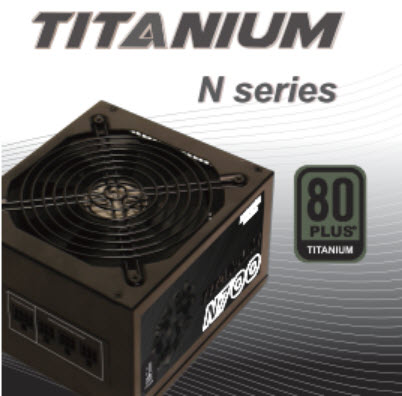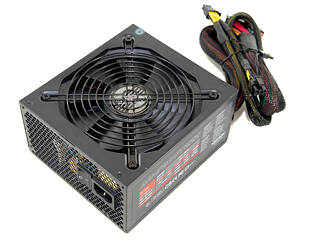 12
12
Andyson Titanium N 700 W Review
(12 Comments) »Introduction

We would like to thank Andyson for supplying the review sample.

Andyson recently introduced a high capacity Platinum series and Titanium line for mid-range systems, which is impressive all on its own. The Titanium N series includes four members with capacities ranging from 500 W to 800 W. All feature a semi-modular cabling design in an effort to keep production costs low. We should stress here that Titanium units are still rare, especially in such capacities as the aforementioned range. Some will probably argue that the efficiency difference between Platinum- or even Gold-certified PSUs and Titanium ones doesn't justify the large price difference, and it really is huge in some cases, so whether you invest in a super efficient Titanium unit or get a more affordable, lower efficiency one is essentially up to you. We do believe that Platinum- and Titanium-certified PSU will become cheaper in due time, especially as even more efficient units are released (Adamantium, anyone?).
Today, the Titanium N700 will be put to the test. This single +12V rail unit doesn't feature a semi-passive operation, which might surprise some of you given it is incredibly efficient. Yet such isn't a deal breaker if its fan operates at very low speeds with light loads. Set aside its efficiency and its specifications are those of a mid-level PSU. However, we are anxious to see how it will perform since it is the first affordable 80 Plus Titanium unit to hit the market.
Specifications
| Andyson Titanium N700 Features & Specs | |
|---|---|
| Max. DC Output | 700W |
| PFC | Active PFC |
| Efficiency | 80 PLUS Titanium |
| Modular | Yes (semi) |
| Intel Haswell Ready | Yes |
| Operating temperature | 0°C - 40°C |
| Protections | Over Voltage Protection Under Voltage Protection Over Power Protection Over Current Protection Short Circuit Protection |
| Cooling | 135 mm Double Ball-Bearing Fan (ADN512DB-A91) |
| Semi-passive operation | No |
| Dimensions | 150 mm (W) x 86 mm (H) x 167 mm (D) |
| Weight | 2.1 kg |
| Compliance | ATX12V v2.4, EPS 2.92 |
| Warranty | 5 years |
| Price at time of review (exc. VAT) | $140 |
The unit comes with all protections except for OTP (Over Temperature Protection), which is a shame since a high-end PSU should definitely come with OTP. The PSU's dimensions are nearly those of a typical PSU with such a capacity, and its price looks good given its Titanium efficiency and five year warranty.
| Andyson Titanium N700Power Specs | |||||||
|---|---|---|---|---|---|---|---|
| Rail | 3.3V | 5V | 12V | 5VSB | -12V | ||
| Max. Power | 20A | 20A | 58A | 2.5A | 0.3A | ||
| 100W | 696W | 12.5W | 3.6W | ||||
| Total Max. Power | 700W | ||||||
Cables & Connectors, Power Distribution
| Native Cables | |
|---|---|
| ATX connector (520mm) | 20+4 pin |
| 4+4 pin EPS12V/ATX12V (645mm) | 1 |
| 6+2 pin PCIe (545mm+145mm) | 2 |
| Modular Cables | |
| 6+2 pin PCIe (500mm+150mm) | 2 |
| SATA (500mm+150mm+150mm+150mm) | 8 |
| 4 pin Molex (500mm+150mm+150mm+150mm) | 4 |
| FDD adapter (+160mm) | 1 |
Cable length is good overall, but the modular PCIe cables should be as long to their first connector as their native counterparts. Andyson probably thinks this PSU will be put into small rather than full tower case, which had them go with such short modular cables. The distance in-between connectors is enough on all cables yet the SATA connectors could be closer to one another. The 24-pin ATX and EPS cables use thicker 16AWG gauges for lower voltage drops at high loads; every other cable uses normal 18AWG gauges, which is as the ATX specification recommends.
Since this PSU features a single +12V rail, we do not have anything to comment on when it comes to its power distribution.
Packaging
The box is rather small, with "Titanium" in large, black font highlighting this units efficiency specification. The corresponding 80 Plus badge is in the bottom-left corner.
Only the power specifications table can be found on the rear of the box.
On this side are an efficiency graph for 115VAC and 230VAC input and a features list. Andyson also states this PSU to be ErP Lot 6 2014 compliant since it consumes less than 0.25 W in standby. Thing is we couldn't find any details on said ErP directive. There is information on the ErP Lot 6 2013 which asks for less than 0.5 W in standby, though.
A graph on this side depicts the fan's speed throughout the unit's entire load range.
A graphical list of all available connectors can be found here.
Contents
The contents of the box are neatly arranged and packing foam surrounds the unit on all sides but the top.
The bundle includes the user's manual, a pouch for the modular cables, a Velcro strap, several zip ties, two sets of fixing bolts, and an AC power cord.
Our Patreon Silver Supporters can read articles in single-page format.
May 17th, 2024 02:29 EDT
change timezone
Latest GPU Drivers
New Forum Posts
- Ghost of Tsushima PC Port !!!! (41)
- What's your latest tech purchase? (20539)
- Razer Blade 18 Laptop / ThrottleStop not working :( (0)
- GPU Temp: 68°C, Hotspot Temp: 100°C (Sapphire Pulse RX 6700XT) (106)
- Fun times with the NR200P, Dual Rad (no special mods needed) (1)
- AM5 boot times improve RADICALLY with memory context restore enabled (75)
- EK seems to be having major issues (88)
- Dell Workstation Owners Club (3096)
- EULA in Games (20)
- 20 Years? (35)
Popular Reviews
- Homeworld 3 Performance Benchmark Review - 35 GPUs Tested
- Enermax REVOLUTION D.F. X 1200 W Review
- Lofree Edge Ultra-Low Profile Wireless Mechanical Keyboard Review
- Silverstone Shark Force 120 mm Fan Review
- Upcoming Hardware Launches 2023 (Updated Feb 2024)
- AMD Ryzen 7 7800X3D Review - The Best Gaming CPU
- ZMF Caldera Closed Planar Magnetic Headphones Review
- Corsair MP700 Pro SE 4 TB Review
- Horizon Forbidden West Performance Benchmark Review - 30 GPUs Tested
- ASUS Radeon RX 7900 GRE TUF OC Review
Controversial News Posts
- Intel Statement on Stability Issues: "Motherboard Makers to Blame" (268)
- AMD to Redesign Ray Tracing Hardware on RDNA 4 (227)
- Windows 11 Now Officially Adware as Microsoft Embeds Ads in the Start Menu (172)
- NVIDIA to Only Launch the Flagship GeForce RTX 5090 in 2024, Rest of the Series in 2025 (154)
- AMD Hits Highest-Ever x86 CPU Market Share in Q1 2024 Across Desktop and Server (138)
- AMD RDNA 5 a "Clean Sheet" Graphics Architecture, RDNA 4 Merely Corrects a Bug Over RDNA 3 (129)
- AMD's RDNA 4 GPUs Could Stick with 18 Gbps GDDR6 Memory (114)
- AMD Ryzen 9 7900X3D Now at a Mouth-watering $329 (104)














